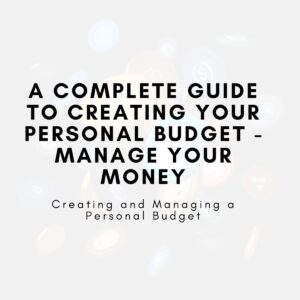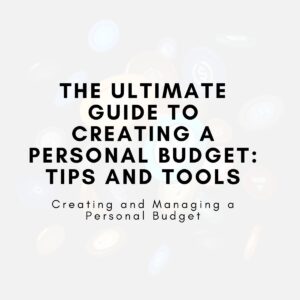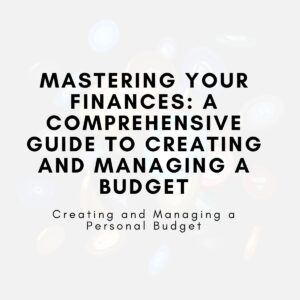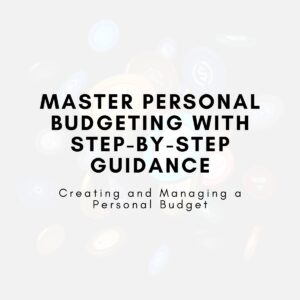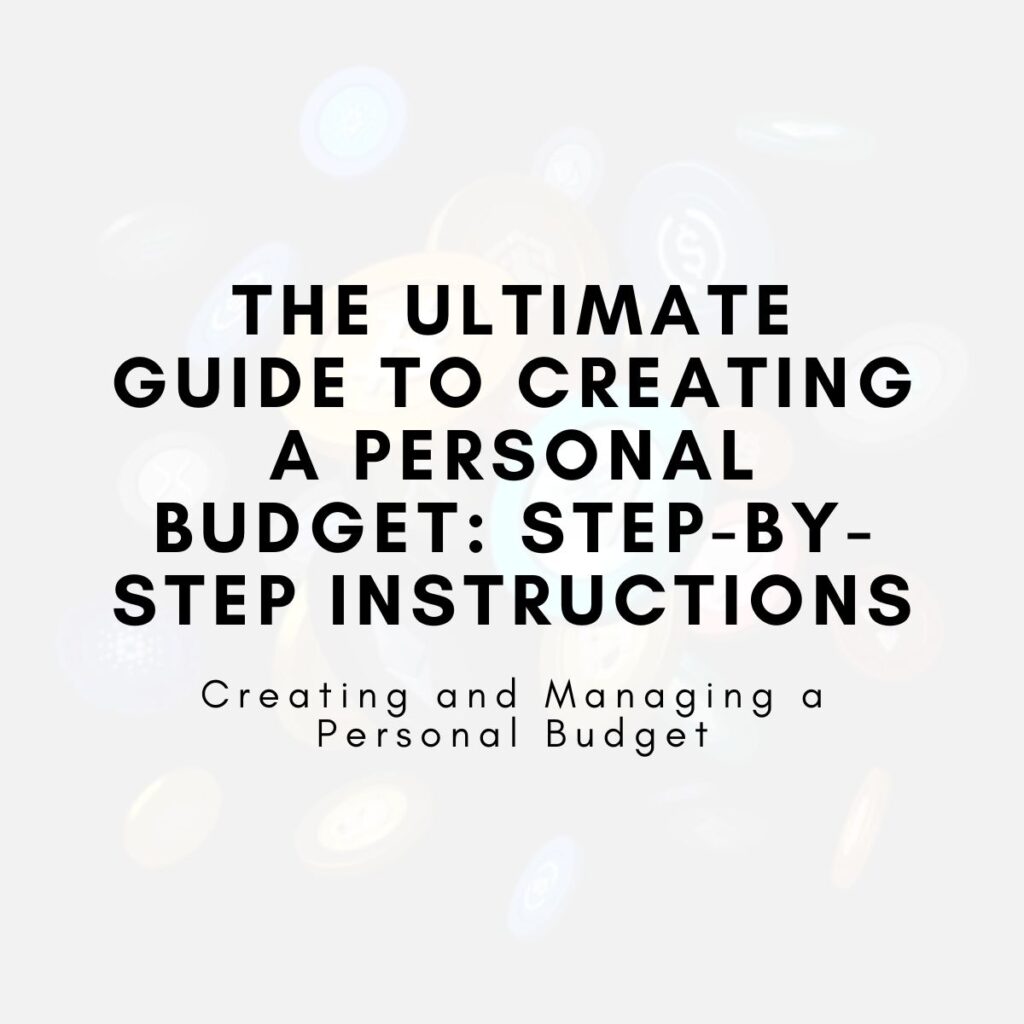
What are the steps to creating a personal budget, and why is it essential for your financial health?
Creating a personal budget is crucial for gaining control of your finances and achieving your financial goals. This ultimate guide provides step-by-step instructions on how to create and manage a budget effectively. Whether you’re saving for the future, paying off debt, or simply trying to understand where your money goes each month, a personal budget will help you stay on track and make informed financial decisions.
Introduction
Managing your finances effectively is one of the most important steps toward financial security. One of the best ways to take control of your finances is by creating a personal budget. A budget allows you to track your income and expenses, make informed decisions about your money, and ensure you are working toward your financial goals. In this guide, we will provide step-by-step instructions for creating a personal budget, discuss different budgeting methods, and offer tips on how to stick to your budget. By the end of this guide, you will be equipped with the knowledge and tools to manage your finances effectively and confidently.
Why Creating a Personal Budget is Essential?
Understand Your Financial Situation
A budget helps you take stock of your financial health by tracking where your money goes each month. For example, if you earn $4,000 monthly and spend $1,500 on rent, $300 on groceries, and $200 on entertainment, a budget will help you see that your discretionary spending may need adjustment. Knowing exactly where your money is going allows you to make better choices, such as cutting back on unnecessary spending or increasing savings.
Set and Achieve Financial Goals
A personal budget helps you allocate money towards your goals. For example, if you want to save $6,000 for a vacation in six months, budgeting $1,000 per month toward that goal will ensure you meet it. Your budget also provides the structure to prioritize paying off debts, building an emergency fund, or saving for future investments.
Prevent Overspending and Debt Accumulation
Without a budget, it’s easy to overspend and accumulate debt. A budget helps you stay on top of your finances by setting limits for each expense category. For example, by setting a maximum of $200 per month for dining out, you can avoid overspending and ensure that your money is going toward more important expenses or savings.
How to Create a Personal Budget: Step-by-Step Instructions?
Step 1: Identify Your Income
The first step in creating a budget is to calculate your total monthly income. This includes your salary, any freelance income, side hustles, or passive income like dividends or rental income. For example, if you earn $3,000 from your full-time job and $500 from a freelance project, your total income would be $3,500. This is the amount you’ll be working with when allocating your expenses.
Step 2: Track and Categorize Your Expenses
Next, list all of your monthly expenses and categorize them into fixed and variable expenses. Fixed expenses include things like rent, mortgage, car payments, and insurance, while variable expenses can be things like groceries, transportation, entertainment, and dining out.
For instance, your monthly expenses might look like this:
- Fixed Expenses:
- Rent: $1,200
- Car Payment: $300
- Insurance: $150
- Variable Expenses:
- Groceries: $350
- Entertainment: $150
- Transportation: $200
By breaking down your expenses, you’ll be able to see where you can potentially reduce spending.
Step 3: Set Financial Goals
Once you know your income and expenses, it’s time to set clear financial goals. These could be short-term goals, like saving for a vacation or paying off a credit card, or long-term goals, such as saving for retirement.
For example, if you want to pay off $5,000 of credit card debt in 10 months, your monthly payment goal would be $500. Allocating this amount in your budget ensures you are actively working toward this goal.
Step 4: Choose a Budgeting Method
There are several methods for budgeting, and it’s essential to choose one that fits your needs. Here are a few options:
- The 50/30/20 Rule: Allocate 50% of your income to needs, 30% to wants, and 20% to savings or debt repayment.
For example, if you earn $3,500 per month, this would break down as follows:- 50% for Needs: $1,750 (for rent, utilities, groceries)
- 30% for Wants: $1,050 (for dining out, entertainment, shopping)
- 20% for Savings/Debt Repayment: $700 (for savings or debt repayment)
- Zero-Based Budgeting: Allocate every dollar to a specific category, ensuring that your expenses and savings account for all of your income.
For example, if your income is $4,000, you might allocate:- Rent: $1,200
- Utilities: $200
- Savings: $500
- Transportation: $300
- Debt Repayment: $800
- Entertainment: $200
This method ensures no money is left unaccounted for.
- The Envelope System: This is a cash-based system where you use physical envelopes to set aside money for each spending category. For example, you might place $300 in an envelope for groceries. When the envelope is empty, you stop spending in that category for the month.
Step 5: Implement and Track Your Budget
Once you have chosen a budgeting method, it’s time to put it into action. Regularly track your income and expenses, and make sure you are sticking to your budget. You can use tools like budgeting apps (e.g., Mint, YNAB), spreadsheets, or even a simple pen-and-paper method.
For example, if your entertainment budget is set at $150, and you spend $100 by the 15th of the month, you know you need to cut back for the rest of the month to stay within your limit.
Step 6: Review and Adjust Your Budget Regularly
Budgets aren’t static; they should evolve as your financial situation changes. Regularly review your budget to ensure it still aligns with your goals. For example, if you get a raise at work or have an unexpected expense, you may need to adjust your budget. If you receive an extra $500, you could decide to put $200 toward savings, $200 toward paying down debt, and allocate the remaining $100 to discretionary spending.
Tips for Sticking to Your Budget
Automate Savings and Bills
Automating your savings and bill payments ensures that you don’t miss any due dates or forget to set aside money for future goals. For example, you can set up an automatic transfer of $200 from your checking account to your savings account each payday. Similarly, you can automate payments for bills like rent, utilities, and insurance, so you don’t have to worry about paying them manually each month.
Cut Back on Unnecessary Spending
Sometimes, the hardest part of budgeting is learning to say no to unnecessary expenses. For instance, instead of dining out three times a week, you could cook at home more often. If you’re paying for multiple subscription services, like streaming platforms or gyms you don’t use, consider canceling them.
Review Your Budget Regularly
Don’t let your budget become an afterthought. Review it monthly or quarterly to make sure you’re on track to meet your goals. For example, if you’re not hitting your savings target, you might need to cut back on discretionary spending or find ways to increase your income.
Using Technology to Manage Your Budget
Budgeting Apps
Budgeting apps like Mint and YNAB make it easy to manage your budget by tracking your income and expenses in real-time. For example, Mint syncs with your bank accounts and credit cards, categorizing transactions automatically, so you don’t have to manually enter every expense.
Spreadsheets and Templates
If you prefer a more hands-on approach, creating your own budget spreadsheet is an excellent option. You can customize it according to your specific needs and track income, expenses, savings, and debt repayment. Google Sheets offers templates you can use to get started, and you can modify them as necessary.
Conclusion
Creating and managing a personal budget is a powerful tool for achieving financial freedom. By tracking your income and expenses, setting goals, and following a clear plan, you can ensure that you’re using your money wisely. Remember, budgeting is a flexible process—adjust your plan as needed, and celebrate your progress along the way. With the right approach and dedication, you can master your finances and reach your financial goals.
Key Takeaways
- A budget helps you understand your financial situation and make informed decisions about your money.
- Set clear financial goals and track your progress regularly to stay on target.
- Use budgeting methods like the 50/30/20 rule, zero-based budgeting, or the envelope system to manage your finances.
- Automate savings and bill payments to make budgeting easier and more consistent.
- Review and adjust your budget regularly to ensure it aligns with your financial goals.
- Use budgeting tools like apps or spreadsheets to simplify the tracking process.

